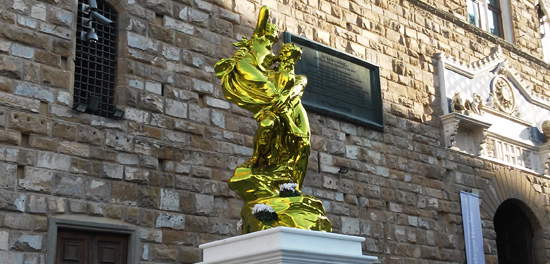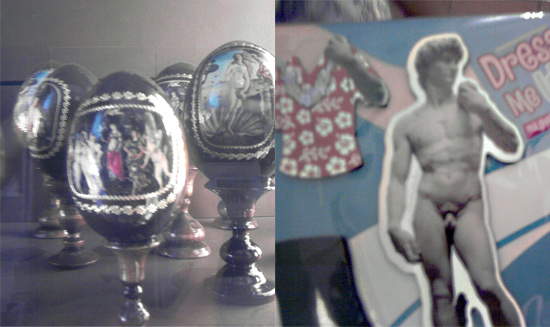Jeff Koons' statue is ideal for celebrating Florence
Never missing from any self-respecting Christmas dinner is the intrusive figure of the old aunt who gives her nephew the usual, atrocious and dreaded technicolor lozenge heavy wool sweater with figures of reindeer and snowflakes. Since time immemorial, generations upon generations of grandchildren have necessarily had to contend with the most classic of Christmas dilemmas: throw the gift away, or wear it for Boxing Day lunch in order to keep the relative happy?
In Florence, just during the holidays that have just passed, the ancient ritual of the unpleasant sweater was renewed, and this time not only, as one might imagine, in the homes of Florentines, but also in the halls of Palazzo Vecchio. The role of the old aunt, in the Florentine Christmas, fell to Jeff Koons, and the City of Florence had to, probably in spite of itself, play the role of the nephew with the forced smile whose turn it is to put on a good face. Indeed, it happened that the American artist-manager, among the most talked-about in the contemporary art scene, had the splendid idea of leaving, "for a long period of time," his Pluto and Proserpina statue plumbed in Piazza della Signoria in October and destined to remain there at least until Jan. 21, the official end date of the initiative that displayed Koons’s work next to statues of the great artists of the 16th century. Evidently, the lavish praise from the press and politicians and the chance to exhibit a work in one of the world’s most famous squares were not enough for Jeff Koons, who in avery clever marketing move presented under the guise of a generous donation (albeit with the right of redemption: it would seem, in fact, that the donation is not perpetual) decided to leave his work in the city.
And now the problem is all about the City of Florence. Dispose of the sweater, or wear it to keep the aunt happy? Certainly, just as the nephew would never dream of wearing the frightening garment when out with friends or girlfriends (on pain of public ridicule), the City of Florence could shelve the idea of placing Koons’ giant Ferrero Rocher in a square, as it was effectively described by a commenter on Facebook. And it could instead put it away from prying eyes, but in a location that would leave no room for criticism from the donor: so we are talking about the Museo del Novecento, the courtyard of Palazzo Medici-Riccardi, or the Teatro dell’Opera.
 |
| Jeff Koons, Pluto and Proserpina (2010-2013). |
I believe, however, that Pluto and Proserpina does not look so bad outdoors, even in Piazza della Signoria, indeed: it is an ideal work for today’s Florence. Mind you, contemporary art should occupy squares and public spaces, and it can and should also dialogue with the ancient. In the past two years alone, there has been no shortage of very clever examples of statues by contemporary sculptors inserted into contexts unchanged for centuries: and not to leave regional boundaries, we could cite the examples of Mitoraj in Piazza dei Miracoli in Pisa, of Cárdenas in the streets of Carrara’s historic center, of Lipchitz in Palazzo Pretorio in Prato. Of course: for the dialogue to be fruitful, it is necessary that contemporary art has something to say or show, and that it is grafted well into the historical-artistic fabric of the place that hosts it. Jeff Koons ’s sculpture can open a dialogue that is anything but strident with the essence of today’s Florence. Jeff Koons has not invented anything new: his greatest contribution to art history, as Luigi Bonfante noted in an extraordinary article published in Doppiozero, is to have introduced the"ennobling of kitsch," to have elevated bad taste to a work of art. His own Pluto and Proserpina is not, as many believe, an interpretation of Gian Lorenzo Bernini’s celebrated Rape of Proserpine: it is simply a reproduction of an 18th-century porcelain that took up the theme of Prosperina’s Rape in turn not by Bernini, but by an artist who was inspired by Bernini’s masterpiece. Koons has, in essence, enlarged and gilded an artifact that can be regarded as little more than a souvenir. Like those, modern ones, that abound in the stalls of all tourist cities, including Florence. But also in museum bookshops: at the Uffizi, for example, terrifying gadgets are on sale (eggs with Botticelli’s Venus, reproductions of Michelangelo’s David equipped with clothes for him to wear) whose bad taste is the same as that which characterizes Jeff Koons’s opera omnia.
 |
| Gadgets for sale at the Uffizi |
And if we consider the act of the donation of Pluto and Proserpina as a commercial move, we cannot fail to find here, too, an assonance with the marketing operations through which the historical-artistic heritage is considered a bargaining chip to set up entertainment exhibitions, or by which certain symbolic places in Florence are turned into locations to be rented out to wealthy celebrities. The same marketing that has turned the city into a kind of amusement park for tourists and has driven the inhabitants away from the historic center could not find greater glorification than a statue that is configured as a product of the same culture that has ruled Florence in recent times. It is foolish to cry out about the alleged outrage perpetrated against the greats of the 16th century: Koons’ work, in Bonfante’s words, “rips the ancient form from its historicity and offers it to the wonder and immediate enjoyment of tourists and children.” And this is the same thing Florence has been doing for years: before being scandalized by Koons’s work, one should therefore be scandalized by the actions of many of the recent municipal, provincial, and even state administrations. There is, in short, a total correspondence between Koons’s statue and the soul of today’s Florence: and it would not be a bad idea if Pluto and Proserpina remained on display in a public square in Florence for a long time. Certainly not because Koons’s art brings innovation, and even less because it brings evolution: Pluto and Proserpina is not an innovative work and does not evolve anything. It simply represents very effectively the decadence of the city: a decadence that, however, has nothing melancholy or romantic about it. It is an empty, kitschy decadence, and nothing could have celebrated it better than Koons’ statue.
Warning: the translation into English of the original Italian article was created using automatic tools. We undertake to review all articles, but we do not guarantee the total absence of inaccuracies in the translation due to the program. You can find the original by clicking on the ITA button. If you find any mistake,please contact us.




























